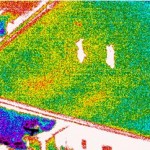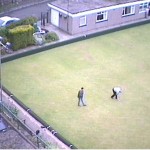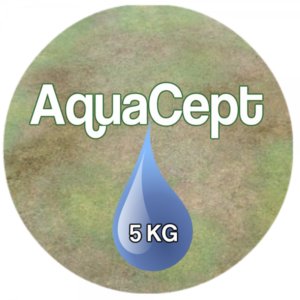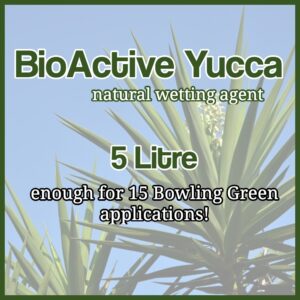
Localised Dry Patch (LDP) is a condition that causes turf to become hydrophobic (water repellent).
Once LDP has taken hold, irrigation simply causes the unaffected areas to get lusher while the LDP affected areas get drier. This exacerbates the problem making the green increasingly frustrating to play on.
Soil sampling will reveal powder dry soil. Unsightly brown patches of turf start to spread over most of the green. The turf on these areas recedes causing a bumpy surface and in most cases the weakened grass will be taken over by moss. But what can be done to cure the problem?
Research shows that fungi can contribute to the onset of this problem. Fungal mycelium may coat individual soil particles making it impossible for water to adhere to them.
Thatch control and irrigation management are the two most critical factors in the management of this problem.
By the time the problem is visually evident it is already too late to achieve an effective cure. This is because the problem is inherent in the green and usually only becomes visible at the height of the season.

Irrigation management requires an understanding of Water Balance in the soil and this is detailed in Performance Bowling Greens. Just look at the infra-red thermographic image on the left, it shows an infrared image of a bowling green. The red areas show the extra heat that is being kicked out by the LDP affected areas, and that is directly related to the lack of moisture retained in the soil in these areas. In the standard photo, the LDP is barely noticeable at this stage, but will get steadily worse.

Frequently we are now seeing that areas affected by dry patch disorders have suffered a complete depletion of moisture and that the soil structure has failed, turning to powder. Traditional wetting agents have sought to address dry patch from a very limited viewpoint, namely the reduction of water surface tension making it easier for water to be attracted and held around individual soil particles.
Although Wetting Agents can be used to good effect on LDP once dry patch has progressed to what we call breaking point, no amount of simple surfactant wetting agent will help it re-wet sufficiently to ensure a full recovery of the turf with full grass cover. Typically the manager has to wait for the turf to over-winter before full grass cover is returned.
This makes it all the more critical that we ensure that the products we use are effective in both results and cost.
As LDP is a disorder within the soil it is important to keep one eye on re-wetting and one on re-building the soil’s health. This can best be achieved by ensuring that you use a wetting agent product which can supply carbohydrates to the soil in addition to their soil re-wetting properties. The addition of a high volume of Carbohydrates ensures that the products also contribute to the maintenance of soil structure while helping stressed grass plants hang on to life for longer while the soil is re-wetting.
Excessive use of sand on bowling greens over the years has been the single biggest influence on the occurrence of LDP.
More on the causes and management of LDP here.



thank you, you have just answered what i thought has happened to the bowling green i play on. cannot get anyone in a position to do anything. ican now show them this article ,again thanks
end of season maintenance starts soon I would like to start. by deep spicking tp let air in and release gases to cure l.d.p.what I do next Im not sure.
? the plant root. is short with powdersandy soil too much top dressing as you described. our local council. as stopped maintenance
in 2011 we took over the maintenance of 2 of the bowling greens in our town, they were badly infected with moss which we have tried to overcome by dosing with a liquid iron solution which seems to have worked. we have applied a spring/summer fertiliser, this seems to have encouraged fast green growth In patches whilst leaving other parts of the green still very slow and in one patch a brown area has appeared.
Do you think this is LDP
In the past the council top dressed the greens most years, we also did this last year.
We have a Dennis ft610 mower with scarifier, verticut, sorrel, and 9 blade cassettes any advice on what to do for the rest of the season would be gratefully accepted. We are a charity organisation with limited resources
Yours in Hope T Beer
Hi Terry
Thanks for your message.
It sounds like you might well have LDP. First thing to do is establish the extent of any problems that exist on the greens.
The best way I know of doing this, is to have a look at what’s going on under the turf and you can get a good idea of this by taking a deep profile sample that will show you a cross section through the green. The best method is to use a sampler like the one pictured in this post, but a border spade will suffice.
You are looking to establish the depth of the thatch layer, any distinct layers in the profile, any funny smells from it and how moist or dry it is. If you can get a deep sample (deeper than 150mm/6″) you should be able to see the contrast between the natural soil the green was built with and the “improved horizon” (top 100mm/4″) where all of the top-dressing has been going over the years. You should also be able to detect any hard, compacted pans as you try to get the sampler in. Make a note of the depth of any noticeable hard layers.
Take several samples across the green and note down what you see re the above. If you can take a sample across the boundary of a normal area/brown area you might be able to see a marked difference in the conditions below the turf. A sample taken from an LDP affected area will typically fall apart as the soil will be powdery dry.
Let me know what you find out and send photos if you can. You can send it all direct to me using the email link at the top of the page.
Good luck
John
I have read the various questions on this matter with interest, because we have identical problems on our new green (constructed 1998/98) our old green 1925 is fine.
Our groundsman is being criticised & is threatening to finish if we do not spend money to cure it!
We have taken soil samples suggested & even after a severe soaking moisture goes down less than 2inches.
Money is tight so how do we fix it ??
Would I be correct in saying we can do nothing now but once we stop bowling, we plan to:- .
1. We spike it every 2 weeks
2. Scarify it in the weeks when we are not spiking ( eg. every 2 weeks)
3. Which wetting agent would be best help for us & at what time of year do we apply this ?? YOUR VIEWS ON OUR PLANS WOULD BE APPRECIATED.
Hi Barry
Thank you for using the site.
First of all can you tell me what you found when you took soil samples in terms of:
Thatch (depth)
Soil Texture (how sandy)
Compaction (how easily did the soil sampler go in and to what depth)
If you can send photographs also that would be great. Also if you can send details of the construction method used for the new green that would be useful.
You can certainly carry out useful maintenance now which as you pointed out will include wetting agent application. This shouldn’t be considered a cure and you shouldn’t give up on it if there isn’t an obvious improvement immediately. You should aim to apply this after making holes in the surface, preferably with a sarrell roller. If there are large brown areas (LDP) you could usefully water these by hand, using the hose and a wetting agent tablet in an applicator. Any proprietary turf wetting agent will do at this stage.
The following articles will be helpful to you in the above:
The Soil texture series starting with this one.
The Fix your bowling green series starting with this one.
I’ll send you an email separately to make it easier to send photos etc.
Regards
John